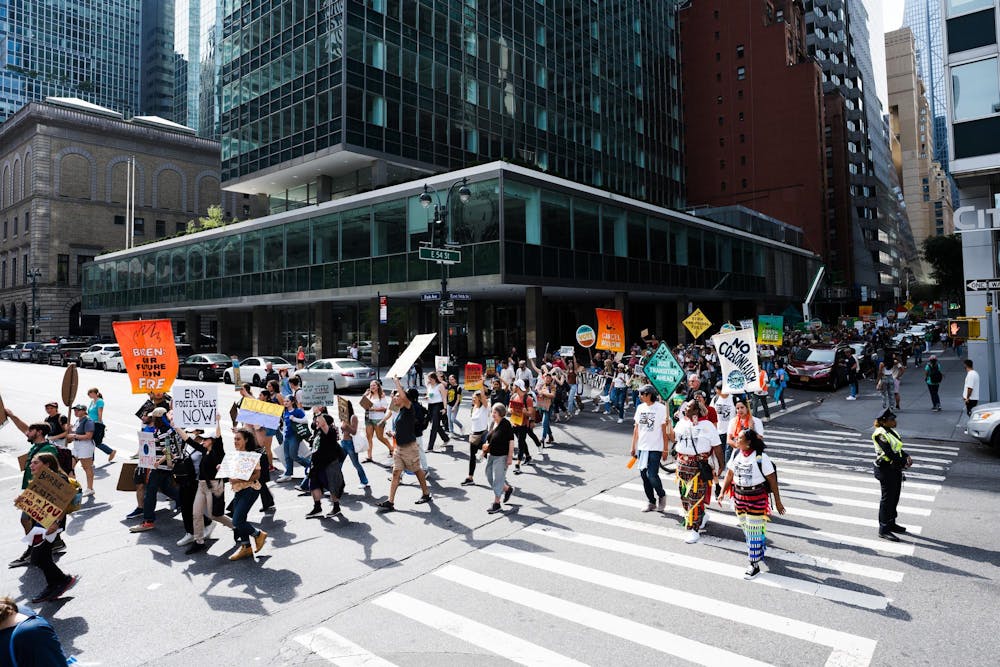Joining together with 75,000 other people, 60 Princetonians took the train up to New York City to tear our throats chanting, brandish hand-made signs, and connect with people who are just as terrified of the climate crisis as we are. As the largest national mass mobilization on climate change since 2019, organizers hosted the March to End Fossil Fuels to call on President Biden to fight harder against a fossil fuel industry that actively sabotages our chances for a liveable future.
Sunday’s march did not end fossil fuels. Indeed, it likely won’t have as much of a direct policy impact as organizers would hope, much like many past marches. If marches do directly shift policy, it’s usually in a small way, disproportionate to the size of the action itself. For instance, on Sept. 20, the Biden Administration announced the establishment of the American Climate Corps,” a green jobs program called for by many climate activists. But Biden’s Corps operates on a far smaller scale than what many have demanded. More to the point, the Biden Administration has not made any new pledges to reduce fossil fuel use since this most recent march.
But direct and immediate policy change may not be the point.
Surrounded by a crowd of people buzzing with outrage and optimism, I felt a different purpose emerge. The march served as a chance to collectively grieve for our planet and to fuel our resolve to act in the future. For issues like the climate crisis, which evokes intense feelings of despair and anxiety, marching alongside countless others becomes all the more significant in countering defeatism with solidarity. The power of a large march is not always in its ability to spur action, but rather, in how it strengthens its own participants.
The deadly heat waves, floods, and wildfires of this summer, as well as the conflict over how to combat them, contribute to a widespread atmosphere of dread about climate change. 59 percent of young people think humanity is doomed, according to a study published in “Lancet Planetary Health,” and a startling 45 percent of people aged 16–25 in the study said that climate anxiety negatively affected daily functioning. This climate despair leads to a certain resignation or defeatism about the crisis: If we’re all doomed anyway, what’s the point of fighting?
The experience of protests like the one on Sept. 17 helps to counteract some of this dread. There, marchers released their climate despair in cathartic chants and collective outrage. I certainly felt this. That day, I walked amidst a crowd so large that I couldn’t see its beginning or its end. I was reminded of just how many people still ardently fought against climate change — by my side were both close friends and people I have never met from all across the country, all marching with the same purpose. Because the march so visibly demonstrated the sheer scale of people who are equally determined to work toward a safer future, the whole experience made clear that none of us are alone in wanting to do something about climate change, and that the fight isn’t over yet.
In the context of the climate movement, that feeling of solidarity is important. After years of building momentum, the movement reached its strongest point in 2019, only to be cut down by the pandemic, which made many demonstrations impossible. While Sept. 17 saw nowhere the numbers of the 2019 Climate Strikes — which recorded around six million demonstrators worldwide on Sept. 26 that year — it signals a return to widespread climate activism, especially among youth.
With the palpable sense of solidarity present in their crowds, large marches empower people to act. Some members of the Princeton contingent had never been to a climate protest before, and they experienced what climate activism can look like firsthand. Others, including myself, had never used a bullhorn. But at the march, we found ourselves walking by major banks that underwrite fossil fuel companies with megaphones in hand, and we used bullhorns to call out these banks directly. Of course, the words we shouted during that march won’t immediately affect the decision-making of Chase, JP Morgan, or CitiBank. At the same time, these experiences give people the courage to take part in future work that will make more of a dent on global emissions and inequality.

To march is to participate in an act that embodies solidarity, inspires hope, and strengthens resolve. It’s these qualities that make large marches like Sept. 17 so impactful, not necessarily to political change, but to individual and collective strength. That’s why I encourage you to join the next march or protest that catches your eye, whether it be related to climate change or not. You might be pleasantly surprised at where it takes you.
Columnist Alex Norbrook (he/him) is a sophomore from Baltimore, Maryland, intending to major in history. He can be reached at alexnorbrook@princeton.edu.









